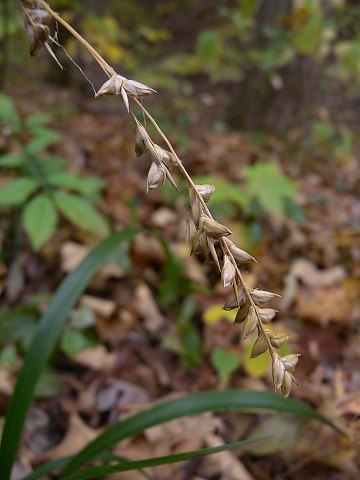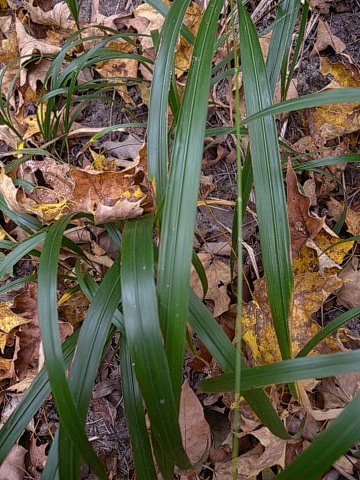
Sterile culms produce only leaves and remain short, while fertile culms become long and produce terminal inflorescences on long naked stalks. Each inflorescence consists of a narrow raceme-like panicle of spikelets about 4-12" long. The lateral branches of the inflorescence are few in number and erect (relative to the central axis); they are 1-4" long and either sparingly branched or unbranched. Both the central axis and lateral branches of the panicle are narrow, somewhat angular, and often rough-textured from minute stiff hairs. Individual spikelets of the lateral branches have a pair of glumes at the bottom, and 1-5 lemmas, paleas, and their florets above. Sometimes the uppermost lemma of a spikelet is sterile and empty. The first glumes are 2.0-3.5 mm. long, ovate, usually single-veined, and
Cultivation: This grass prefers light shade, moist to dry-mesic conditions, and soil containing loam or silt-loam with abundant decaying leaves. It can be propagated by seed or division of the rhizomes, and used as a ground cover in shaded areas.
Range & Habitat: The native Beak Grass is scattered throughout Illinois; this grass is occasional in high quality natural areas, otherwise it is uncommon to absent. Habitats consist of upland woodlands to floodplain woodlands, wooded slopes along bluffs, and shaded limestone cliffs. In floodplain woodlands, the grains of this grass can be distributed by water. Various deciduous trees are dominant in the preceding habitats.
Faunal Associations: Information about floral-faunal relationships for this grass is very limited. The caterpillars of a moth, Elachista subalbidella (Dwarf Buff), mine the leaves of Beak Grass. More research in this area is needed. The large seeds are probably an attractive source of food to upland gamebirds and small rodents that inhabit wooded areas.
Photographic Location: Along a wooded slope at Fox Ridge State Park in Coles County, Illinois.

Comments: Beak Grass has very distinctive grains that are large in size and oddly shaped. On this basis, it is easily distinguished from other grasses that are outside its genus. In the past, Beak Grass was considered a variety of American Beak Grass, or Diarrhena americana obovata. However, it is now considered a distinct species with a more northern range. In Illinois, Beak Grass is more common and widely distributed than American Beak Grass; the latter is restricted to the southern tip of Illinois, where it is rare. These two species can be distinguished from each other as follows: 1) Beak Grass (Diarrhena obovata) has lemmas that are less than 7.0 mm. long, while the lemmas of American Beak Grass (Diarrhena americana) are often greater than 7.0 mm. long; 2) the width of the mature grains for Beak Grass exceeds 1.8 mm. across, while the mature grains of American Beak Grass are less than 1.8 mm. across; and 3) the central axis of the inflorescence for Beak Grass has minute hairs that are less than 0.5 mm. in length, while the central axis of the inflorescence for American Beak Grass has some hairs that exceed 0.5 mm. in length. In the absence of their inflorescences, these two species are difficult to distinguish, but American Beak Grass tends to be more pubescent overall than Beak Grass.